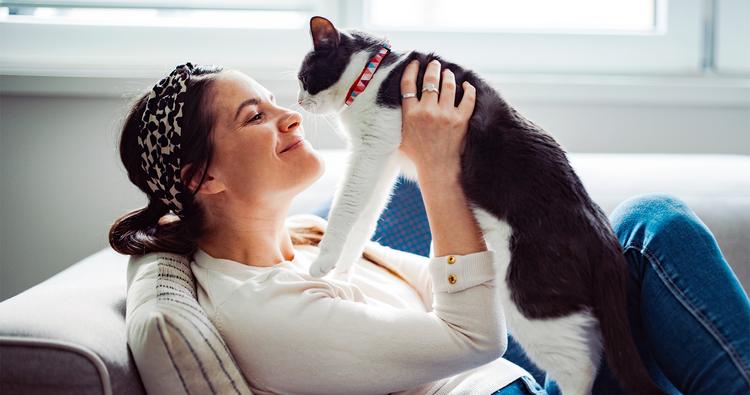How Do Working Cat Adoption Programs Work?
Indoor life isn’t for every cat. Working-cat programs offer a happy, productive alternative.
Indoor life isn’t for every cat. Working-cat programs offer a happy, productive alternative.
by Janelle Leeson, | May 27, 2024

Kevin Keller / Stocksy
Is your property facing an ongoing problem with outdoor pests? Do you have a few acres of land with an outdoor shelter? If so, you might have an ideal home for a working cat. Working-cat placement pros Holly Skalak of Ruff Start Rescue and Emily James of Heartland Humane Shelter and Care explain what a working cat is and when one might be advantageous for you.
There’s more than one type of cat who comes through shelter doors. There are friendly cats whom shelters match with loving homes, and healthy feral or semi-feral cats (those who aren’t social) returned to their outdoor communities after neutering or spaying, called trap, neuter, release (or TNR).
Working cats — also known as barn cats — are those who fall somewhere in between. They are healthy adult cats who are not particularly friendly toward humans and should not live in an indoor environment. But at the same time, they can’t be re-released to the unsafe or unhealthy location where they were found.
No, working cats are not suitable as pets. Working-cat programs are not for those seeking a cuddly companion, but can be ideal for someone with outdoor facilities and a rodent problem. These outdoor cats tend to be shy or even semi-feral. Says Skalak, “They prefer to keep their distance and don’t usually enjoy being handled.”
Working-cat programs are an all-around win for cats, shelters, and pest control. Rather than resorting to euthanasia, shelters can offer a happy, active life to adult cats who aren’t quite cut out for indoor living — yet can’t be returned to where they were trapped. These mousers get placed on farms, wineries, and other locations where they can roam about and do what they do best: hunt.
Working cats help control pest populations naturally, reducing the need for harsh chemicals like pesticides and rodenticides. However, these cats will not discriminate between hunting a nuisance rodent and a threatened songbird. Cautions James, “Research into local wildlife populations and distribution can help you make informed decisions.”
Working cats don’t need all the amenities of indoor life to stick around, just the essentials: food, water, and shelter. Without them, James notes, your working cat will simply leave.
While it might seem counterintuitive, James says it’s important to provide working cats with complete, balanced commercial cat food. Don’t worry, cats are opportunistic hunters, so they’ll have the urge to hunt regardless of hunger levels.
All cats should have access to clean, fresh water. Providing water bowls on-site and keeping them fresh can discourage your working cat from venturing too far off your property in search of hydration.
Providing shelter will help keep your cat safe from predators and the elements. An existing barn or outbuilding with a pet door can offer a secure spot. Alternatively, you can make an outdoor cat house.
Not all working cats need a dedicated litter box, because they can typically find other places to poop and pee. That said, if you don’t want your working cat going anywhere and everywhere, offering a few litter boxes is your best bet.
Worried about outdoor hazards such as busy roads? There are strategies to mitigate them (like installing a high fence), but they come with a cost. The best way to decide if a working cat is right for your property is to speak with experienced shelter staff and volunteers, who can offer years of practical advice.
Not all shelters and rescues offer working-cat programs. If this is a route you’re interested in, check with your local shelters or rescue organizations to see if they offer it. You can search for shelters in your area using the Adopt a Pet database.
You can keep a working cat or barn cat on your property by meeting their basic needs. Provide them with reliable sources of food, water, and shelter. This not only discourages them from roaming in search of these essential resources but also frees up their time and energy for more hunting.
These cats can typically find places to poop and pee, but you may not like where they choose to go. To discourage unwanted bathroom spots, consider offering a few litter boxes.
According to James, working cats and barn cats typically live for around 10 years, which might seem short compared to the average lifespan of indoor cats. However, the alternative to turning felines into working cats or barn cats is often euthanasia. “We understand that people are philosophically split on this issue,” James says. “While not perfect, we consider the working-cat program to be harm reduction for an at-risk population of cats.”
“The general rule is four cats per barn,” James says. “This creates a sense of security and companionship for them. Ideally, these cats would come from the same original location or colony, but that’s not always possible.

Janelle Leeson is a Portland, Oregon-based freelance writer. Her work has been featured in magazines such as Inside Your Dog’s Mind, Inside Your Cat’s Mind, and Paw Print, as well online at Insider Reviews, NBC Select, Shop Today, PetMD, and Daily Paws. She has two adventure cats, a flock of urban chickens, and a soon-to-be-husband who doesn’t mind housing the occasional foster cat — or five.

Behavior & Training

Behavior & Training

Shelters & Rescue

Behavior & Training


Rehome
Found a stray cat? Follow these steps to ensure their well-being while you search for their people.

Adoption Advice
These giant guinea pigs are smart and social, so what could go wrong? Read on to better understand why these animals don’t make good pets, and why they’re outlawed in several places.


Adoption Advice
For the most part, they are. But here are some important things to consider while looking for that perfect kitty collar.

Behavior & Training

Behavior & Training

Behavior & Training

Behavior & Training

Behavior & Training
